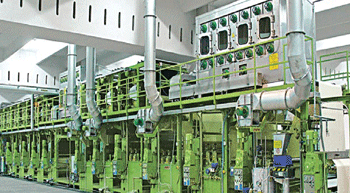
IndigoGenius®: The eco technology of the future
A creative idea, a happy basic intuition, verified as for its efficiency and fine-tuned through a long series of experiments carried out on the IndigoLab machine, suitably updated for this purpose, at the Italy-based Master´s research & development (R&D) department enabled the company to industrialise the revolutionary, eco-friendly,
GENIUS® is an integrated module to dye with indigo and sulphur dyes in a nitrogen atmosphere.
A creative idea, a happy basic intuition, verified as for its efficiency and fine-tuned through a long series of experiments carried out on the IndigoLab machine, suitably updated for this purpose, at the Italy-based Master´s research & development (R&D) department enabled the company to industrialise the revolutionary, eco-friendly, and low-cost dyeing technology with indigo and sulphur dyes in the modules (patented).
The GENIUS® module:
GENIUS® is an integrated module to dye with indigo and sulphur dyes in a nitrogen atmosphere, made up of a dyeing vat and a special diffusion/fixation unit of the soluble-state (leuco) dye to the yarn, which can be differentiated according to heat activation and the duration of stay in an inert environment.
Basically, GENIUS« has added a fourth operational stage, that is the diffusion/fixation of the leuco dye in an inert environment, where also the dipping and squeezing of the yarn occur, to the classical method of indigo dyeing, common to all traditional machines, primarily made up of three operational stages repeated several times: impregnation of the yarn with the leuco dye, squeezing out of the excess dye bath and oxidation by exposing the dyed yarn to air.
In the GENIUS« (pat.) modules the indigo chemical reduction is full and perfect, and the leuco dye is separated into nanometric size particles; its dyeing power makes it penetrate and fix to the fibre better than using a traditional system, which in some cases also allows eliminating the fixing agent even though working with a higher concentration of dye in the bath.
This original working condition in an inert environment and closed circuit allows eliminating some problems of the classic system compared to which it has the advantages not only to drastically reduce the consumption of caustic soda and hydrosulfite but also to considerably save washing water, thanks to a better fixation of the dye to the yarn.
Furthermore, when dyeing with sulphur dyes, in particular black, a greater colour yield is obtained, optically estimated around 40 per cent with a remarkably higher degree of fixation and improved brilliance, compared to the dyeings made using traditional machines.
To obtain the greatest flexibility on the final result in terms of corticality and degree of fixation, besides the known physical/chemical variables, the GENIUS® modules are also equipped to vary the bath-fibre contact time, the duration of stay in the diffusion/fixation unit and its use with or without yarn heating.
All versions of the GENIUS®modules are covered by international patents. Advanced technology continuous, slasher and rope dyeing machines of warp chains for denim indigo and sulphur dyes in nitrogen atmosphere making use of the new, ingenious, fabrics with friendly, and low-cost technology of two or more GENIUS® (pat.) modules.
They are the result of our fifty-year experience in the specific field of yarn dyeing and expression of the highest technology in this sector.
They are characterised by completeness and the greatest operational flexibility, and due to their specific and exclusive design features, they allow reducing the number of dyeing vats for high-quality, eco-friendly, and low-cost productions. Thanks to IndigoGenius« (pat.) the continuos dyeing technology with indigo and sulphur dyes takes new features: advanced technology is the means, ecology and savings are the results.
The technical advantages are:
- Dyeing process independent of external variables.
- Better diffusion and fixation of the indigo and sulphur dyes to the fibre.
- Higher dyeing yield (about 40 per cent with sulphur dyes)
- Use of about half the number of dy




